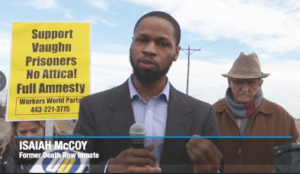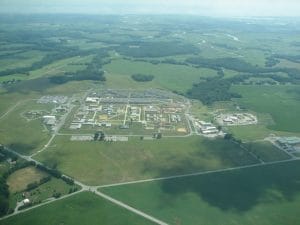At Vaughn prison and elsewhere, we should demand transparency and stand with the inmates who dare to affirm their humanity.
On Feb. 1, scores of men in Delaware’s largest prison, the Vaughn Correctional Center, took over one of the buildings in their facility. The prison, built in 1971 and known for its serious overuse of solitary confinement, is one of the state’s most severely overcrowded and punitive facilities.

Hoping to push the state to improve living conditions at Vaughn, the prisoners didn’t just take control of Building C – they also took guards hostage. And to make the public aware of why they were protesting, they called the media:
“We’re trying to explain the reasons for doing what we’re doing. Donald Trump. Everything that he did. All the things that he’s doing now. We know that the institution is going to change for the worse. We know the institution is going to change for the worse. We got demands that you need to pay attention to, that you need to listen to and you need to let them know. Education, we want education first and foremost. We want a rehabilitation program that works for everybody. We want the money to be allocated so we can know exactly what is going on in the prison, the budget.”
Over the next few hours, the men in Vaughn released all but two of the hostages and let 19 prisoners, who wanted to, leave the building as well. Meanwhile, law enforcement had begun amassing outside of the prison.
At dawn, the police stormed the facility.
By 7 a.m., the ground outside the prison was littered with prisoners lying face down on the concrete with their hands behind their back. One of the hostages was on her way to the hospital. Tragically, the other was dead.
That’s all we really know. Reliant on information funneled straight through the prison officials’ PR machine, and with no access to the men inside, we have no idea what the fallout from this rebellion is or might be.
This lack of transparency is typical – and it has terrible consequences.
The history of prison rebellions in this country shows we should be very cautious when we have to depend on state officials to tell us what happened, or is still happening, in any penal facility experiencing unrest.
Take Attica. Just three weeks ago, guards placed the New York State facility under complete lockdown. According to corrections officials, this was in reaction to a series of fights that had broken out between prisoners there.
The men in this facility remained under lockdown for several days – it’s unclear how many – and each undoubtedly had his small cell “tossed”: his property thrown about and destroyed as guards searched for “contraband.” According to Attica’s correction officer union, the lockdown was necessary “to get to the root of what happened.”
This lack of transparency is typical – and it has terrible consequences. The history of prison rebellions in this country shows we should be very cautious when we have to depend on state officials to tell us what happened, or is still happening, in any penal facility experiencing unrest.
But there’s plenty of reason to doubt the guards’ account of the unrest and their subsequent actions, just as there are reasons to be very worried about what’s happening to the men at Vaughn right now.
Again, Attica is instructive. Forty-six years ago, Attica was the site of one of the most dramatic prison uprisings in American history.
On Sept. 9, 1971, nearly 1,300 men rose up in protest against the prison’s awful conditions. But rather than recognize the cause of the crisis, and work to address it, the state of New York sent in hundreds of troopers, who shot and severely injured 128 men and killed 39 – prisoners and prison guards alike.
There’s plenty of reason to doubt the guards’ account of the unrest and their subsequent actions, just as there are reasons to be very worried about what’s happening to the men at Vaughn right now.
Today, in prisons across the country, the conditions that sparked the Attica uprising are even worse. Prisons are more overcrowded. Food rations are meager and, since meal services are often contracted out to for-profit companies, that food is sometimes spoiled and rotten.
Medical care is substandard and, again thanks to privatization, is often legally negligent. Prisoners are kept for long periods of time in solitary confinement and face serious physical abuse – often accompanied by racial epithets and threats – from officers who already retain utter control over them.

So when we hear prisoners are on lockdown for fighting – rather than for revolting against deplorable living conditions – or when we witness another forcible retaking of a penal facility, we should be both skeptical and concerned.
Correction officials have a history of painting prisoners as violent thugs and insisting that authorities’ only aim is to restore order and safety for all. At Attica, prison officials have a long and well-documented track record of lying about the men in their charge and literally torturing those who dare to rebel.
So when we hear prisoners are on lockdown for fighting – rather than for revolting against deplorable living conditions – or when we witness another forcible retaking of a penal facility, we should be both skeptical and concerned.
The case of Kinross
It isn’t simply Attica’s history that should make us concerned about what might be transpiring now at Vaughn. Just this past September, on the 45th anniversary of the Attica rebellion, prisoners throughout the U.S. went on strike against forced prison labor and the terrible conditions in which they live.
Not surprisingly, corrections officials once again tried to spin this unrest by stressing the illegitimacy of the prisoners’ actions: These were but violent criminals who had gone on a rampage, and they would be dealt with accordingly.
The men and women in these facilities relay a very different story.
It isn’t simply Attica’s history that should make us concerned about what might be transpiring now at Vaughn.
Thanks to the efforts of several family members of prisoners – as well as a local organization called Michigan Abolition and Prisoner Solidarity (MAPS) – we have a much clearer picture of what transpired at one prison in particular: Michigan’s Kinross Correctional Facility.
For starters, we now know that before the men in Kinross launched a formal work stoppage, they had made several attempts to peacefully convey their demand for more humane living conditions.
As one man explained in a Dec. 20 letter to MAPS, he and his fellow prisoners had grown desperate “to be treated as human beings, not like animals in a cage.” The prisoners at Kinross live in terribly overcrowded facilities – “eight men in a cube made for four” – and routinely endure “racist statements like ‘Don’t let me get the whip back out for you!’”
They were even forbidden from hugging their children during prison visits, apart from hello and goodbye. “Imagine a child looking, coming to hug, and a voice on intercom forbidding child to do so?” the same prisoner wrote. “Child looks at Dad wondering if he’s diseased or what? And can’t touch their father?”
For starters, we now know that before the men in Kinross launched a formal work stoppage, they had made several attempts to peacefully convey their demand for more humane living conditions.
Increasingly in despair over their situation, prisoners chose block representatives to bring their grievances to the administration. But when they did, several prisoners report, guards destroyed their meager personal possessions and moved them to another facility.
The men then tried to press their concerns through a series of peaceful demonstrations of unity. “Everyone stood in front of their perspective units for the last 30 min(utes) of afternoon yard,” another Kinross prisoner wrote, describing one such action. “It was to let KCF administration know that we were fed up and things had to change.” Still nothing changed.
Increasingly in despair over their situation, prisoners chose block representatives to bring their grievances to the administration. The men then tried to press their concerns through a series of peaceful demonstrations of unity. Still nothing changed.
So they planned a strike for Sept. 9. Their hope? That a broader nonviolent action might attract the public’s attention and perhaps, finally, win them some improvements.
According to numerous letters, the strike went off peacefully, both when the men refused to show up to work on Sept. 9 and the next day when they amassed in the yard and met with administrators. Prison administrators promised to address at least some of the grievances they voiced that day, and the prisoners agreed to return to their cells.
But after they did so, the prisoners were rushed by a heavily armed Emergency Response Team – at a state expense of nearly a million dollars.
Chaos and terror ensued. Prisoners were tear gassed and made to stand for hours outside in the freezing rain, and prison property was destroyed.
According to corrections officials, it was an all-out riot. But, as one of the prisoners insists, what made it violent and ugly was prison management’s choice to retaliate.
Prisoners were tear gassed and made to stand for hours outside in the freezing rain, and prison property was destroyed.
“Regardless of what KCF staff claim,” he wrote, “this could have been prevented. If anything, they incited a riot by lying about what they were going to do to change things.” Another Kinross prisoner echoed that account: “The administration went to the media and lied to the public about the demonstration, and tried to make it seem like we was the problem.”
Those on the outside never heard these stories. Instead, they were assured that order was being restored and steps were being taken to ensure the safety of staff and inmates alike. The troublemakers who had caused the “riot” would be moved into segregation, where they would face charges for what they had done. All would soon be well again.
But all, according to scores of Kinross’s prisoners, is hardly well. While even prison officials concede that, as one prisoner noted, “It was nothing but property damage,” these men have suffered severe retaliation.
“Prisoners were held in terrible conditions in temporarily reopened units,” MAPS spokesperson Alejo Stark reports, and although “more than a hundred prisoners were transferred and released from the hole [solitary] after several weeks, an estimated 150 prisoners are still in the hole” at their new facilities and now face “punishments of one to two years in very harsh administrative segregation conditions.”
But all, according to scores of Kinross’s prisoners, is hardly well. While even prison officials concede that, as one prisoner noted, “It was nothing but property damage,” these men have suffered severe retaliation.
As one prisoner described: “They put me in Unit 5 in the observation cell 125. The cell was a mess. The cell smelled like urine and feces, the toilet hadn’t been flushed in over two months, the floor was sticky and unbearable. The toilet had been stained from all the waste in it …
“Over time I cleaned the place up, but the stain in the toilet bowl is there for life. After 70 days of people watching me use the toilet, they finally moved me down the hall from where I was.”
Standing with prisoners
From Attica in 1971 to Kinross in 2016 to Vaughn in 2017, our nation’s prisons are the picture of barbarity. Prisoners are beaten, degraded, starved and treated as less than human. They effectively lose their right to due process and have no protection from cruel and unusual punishment.
According to Joe Miano, an official with the New York State Corrections Officers Police Benevolent Association, Attica’s lockdown last month was “a clear example of the increasingly high levels of violence and dangerous weapons plaguing our prisons.”

But according to the human beings locked in this prison and others across the country, the real issue remains one of overcrowding and abuse.
At Vaughn Correctional Center, inmates have complained for years about their prison environment.
“They just got to the point where they’re fed up,” a former inmate told the News Journal. “If [the Department of Correction] is worried about the officers and not their demands, if nothing changes, I guarantee there will be another hostage situation in a different building.”
While state officials and the prison guard union would prefer to keep those conditions hidden behind the prison walls, it’s up to us to demand transparency and stand with the prisoners daring to affirm their humanity.
As one prisoner at Kinross wrote: “We need help. I’m shouting out from this 8-by-10-foot cell, ‘Help us! Don’t let them quiet our voice. Be an amplifier for us. Don’t let what they are doing to us and throughout the MDOC fade into oblivion.”
Heather Ann Thompson is a historian at the University of Michigan and the author most recently of “Blood in the Water: The Attica Prison Uprising of 1971 and its Legacy,” a finalist for the National Book Award. This story first appeared in Jacobin. Learn more and contact her via her website.
Prisoners speak out about the Vaughn Rebellion
The chickens have come home to roost
by DeShawn Drumgo Sr., cousin of Soledad Brother Fleeta Drumgo
I am reporting to you live from this place called Hellaware (Delaware), where there are 120 of us alleged to be suspects in the murder of a correctional officer here in Smyrna, Delaware. [All 120 prisoners housed in C Building, where Lt. Steven Floyd Sr. was killed, are considered suspects, according to DelawareOnline.com.]

I believe at least 110 of us were hog-tied and beaten while subdued. You’ll see this is nothing new at James T. Vaughn Correctional Center if you check my log of civil suits launched and reversed in the 3rd Circuit Court of Appeals in Philadelphia.
For years I have tried to make the world aware of the injustices, racial indifference and torment that I and 300 to 500 others have suffered in this torture chamber known as the SHU. I myself have spent almost a decade in the SHU, and often I put packets together for the House of Representatives, the mayor, the governor, the president of the USA, telling them that Vaughn Prison is raising monsters!
“Being an old farm boy myself,” Malcolm X said, “chickens coming home to roost never did make me sad; they always made me glad.”
Delaware’s top brass turned out to shed tears, ring bells, salute, apologize and give medals to the family of the fascist correctional officer who died. But there were no tears shed, bells run, salutes, apologies nor medals given to the families of Jason Cunningham, killed by corrections officers here at JTVCC, nor for Ronald Shoup, killed by DOC, nor Arias nor Blaise P. DeJesus, Anthony Pierce or Jermaine Lamar Wilson, who lost their lives in the torture chambers of the SHU.
“What really caused Delaware’s prisoners to revolt at Vaughn Correctional Center” reports what journalists learned about those deaths and more from interviews The News Journal held with “three dozen inmates and their families, prison advocates, and former and current correctional officers, (who) said anyone at the James T. Vaughn Correctional Center could see the deadly standoff coming.”
Send our brother some love and light: DeShawn Drumgo Sr., 365566, JTVCC 17C-U2, 1181 Paddock Rd, Smyrna DE 19977.
JTVCC Uprising
by Christopher West
The “alternative facts” have already begun to swarm around JTVCC (James T. Vaughn Correctional Center) like a stench cloud of the bullshit that they are. On Feb. 1, Building C was taken over for 18 hours in prisoner revolt.
At the end, when a backhoe broke through the wall, Sgt. Steven Floyd (promoted posthumously to lieutenant) was found dead. A female counselor was protected by a small contingent.
The COAD, Correctional Officers Association of Delaware, through its spokesman, Geoff Klopp, tried to spin the incident as the direct result of the recent ACLU-CLASI (Community Legal Aid Society, Inc.) victory for mental illness treatment and solitary reform. The actual cause of the revolt was the oppressive conditions prisoners at JTVCC have faced for years.
SHU prisoners being allowed out of their cells for only three hours a week is one example. And there are no meaningful opportunities for self-improvement.
They also tried to portray Floyd as a great correctional officer and hero, when in fact everyone knows he was a coward who sadistically targeted and oppressed his own (Black) people.
As the lawsuits fly and truth gets twisted, let us hope true justice will prevail for us, the oppressed slave class.
Send our brother some love and light: Christopher West, 415857, JTVCC Unit 21-C, 1181 Paddock Rd, Smyrna DE 19977.






